系统启动和内核管理
Posted zhaihongyu
tags:
篇首语:本文由小常识网(cha138.com)小编为大家整理,主要介绍了系统启动和内核管理相关的知识,希望对你有一定的参考价值。
系统启动和内核管理
1 CentOS 6 的启动管理
1.1 Linux 组成
kernel 实现进程管理、内存管理、网络管理、驱动程序、文件系统、安全功能等功能
rootfs 包括程序和 glibc 库
程序:二进制执行文件
库:函数集合, function, 调用接口(头文件负责描述)
1.2 内核设计流派
宏内核(monolithic kernel):又称单内核和强内核,Unix,Linux
把所有系统服务都放到内核里,所有功能集成于同一个程序,分层实现不同功能,系统庞大复杂,
Linux其实在单内核内核实现了模块化,也就相当于吸收了微内核的优点
微内核(micro kernel):Windows,Solaris,HarmonyOS
简化内核功能,在内核之外的用户态尽可能多地实现系统服务,同时加入相互之间的安全保护,每
种功能使用一个单独子系统实现,将内核功能移到用户空间,性能差
1.3 CentOS 6启动流程
1.3.1 CentOS 6 启动流程
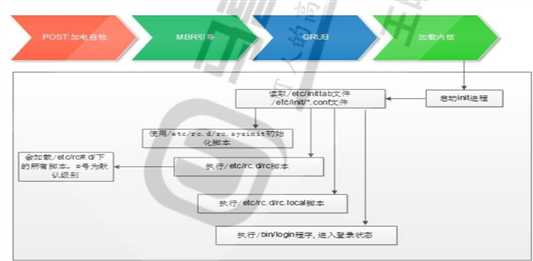
1. 加载Bios的硬件信息,获取第一个启动设备
2. 读取第一个启动设备MBR的引导加载程序(grub)的启动信息
3. 加载核心操作系统的核心信息,核心开始解压缩,并尝试驱动所有的硬件设备
4. 核心执行init程序,并获取默认的运行信息
5. init程序执行/etc/rc.d/rc.sysinit文件,重新挂载根文件系统
6. 启动核心的外挂模块
7. init执行运行的各个批处理文件(scripts)
8. init执行/etc/rc.d/rc.local
9. 执行/bin/login程序,等待用户登录
10. 登录之后开始以Shell控制主机
1.3.1 硬件启动POST
POST:Power-On-Self-Test,加电自检,是BIOS功能的一个主要部分。负责完成对CPU、主板、内
存、硬盘子系统、显示子系统、串并行接口、键盘等硬件情况的检测
主板的ROM:BIOS,Basic Input and Output System,保存着有关计算机系统最重要的基本输入输出
程序,系统信息设置、开机加电自检程序和系统启动自举程序等
主板的RAM:CMOS互补金属氧化物半导体,保存各项参数的设定,按次序查找引导设备,第一个有引
导程序的设备为本次启动设备
1.3.2 启动加载器 bootloader
1.3.2.1 grub 功能和组成
bootloader: 引导加载器,引导程序
windows: ntloader,仅是启动OS
Linux:功能丰富,提供菜单,允许用户选择要启动系统或不同的内核版本;把用户选定的内核装
载到内存中的特定空间中,解压、展开,并把系统控制权移交给内核
Linux的bootloader
LILO:LInux LOader,早期的bootloader,功能单一
GRUB: GRand Unified Bootloader, CentOS 6 GRUB 0.97: GRUB Legacy, CentOS 7 以后使用
GRUB 2.02
GRUB 启动阶段
primary boot loader :
1st stage:MBR的前446个字节
1.5 stage: mbr 之后的扇区,让stage1中的bootloader能识别stage2所在的分区上的文件系统
secondary boot loader :2nd stage,分区文件/boot/grub/
1.3.2.2 CentOS 6 grub 安装
安装grub:
(1) grub-install 安装grub stage1和stage1_5到/dev/DISK磁盘上,并复制GRUB相关文件到 DIR/boot
目录下
grub-install --root-directory=DIR /dev/DISK
(2) grub
grub> root (hd#,#)
grub> setup (hd#)
范例:修复grub的第1阶段故障
#破坏grub第1阶段
[root@centos6 grub]#dd if=/dev/zero of=/dev/sda bs=1 count=446
446+0 records in
446+0 records out
446 bytes (446 B) copied, 0.000871905 s, 512 kB/s
root@centos6 grub]#reboot
#无法启动,出现下面提示
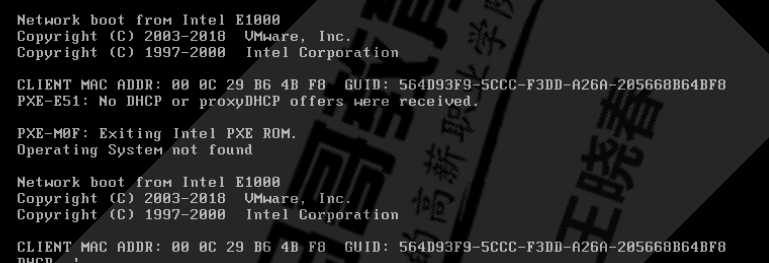
光盘启动,进入rescue模式
#chroot /mnt/sysimage
#grub-install /dev/sda
#sync
#exit
#exit
[root@centos6 ~]#dd if=/dev/zero of=/dev/sda bs=1 count=446
446+0 records in
446+0 records out
446 bytes (446 B) copied, 0.00070171 s, 636 kB/s
[root@centos6 ~]#grub
Probing devices to guess BIOS drives. This may take a long time.
?GNU GRUB version 0.97 (640K lower / 3072K upper memory)
[ Minimal BASH-like line editing is supported. For the first word, TAB
?lists possible command completions. Anywhere else TAB lists the possible
?completions of a device/filename.]
grub> root (hd0,0)
root (hd0,0)
Filesystem type is ext2fs, partition type 0x83
grub> setup (hd0)
setup (hd0)
Checking if "/boot/grub/stage1" exists... no
Checking if "/grub/stage1" exists... yes
Checking if "/grub/stage2" exists... yes
Checking if "/grub/e2fs_stage1_5" exists... yes
Running "embed /grub/e2fs_stage1_5 (hd0)"... ?27 sectors are embedded.
succeeded
Running "install /grub/stage1 (hd0) (hd0)1+27 p (hd0,0)/grub/stage2
/grub/grub.conf"... succeeded
Done.
grub> quit
范例:修复grub的第1.5 阶段故障
[root@centos6 ~]#dd if=/dev/zero of=/dev/sda bs=512 count=25 seek=1
[root@centos6 ~]#reboot
#无法启动,显示下面界面

光盘启动,进入rescue模式
#chroot /mnt/sysimage
#grub-install /dev/sda
#sync
#按 ctrl+alt+delete 三个键重启动
1.3.2.3 grub legacy 管理
配置文件:/boot/grub/grub.conf <-- /etc/grub.conf
stage2及内核等通常放置于一个基本磁盘分区
grub legacy 功用:
(1) 提供启动菜单、并提供交互式接口
a:内核参数
e:编辑模式,用于编辑菜单
c:命令模式,交互式接口
(2) 加载用户选择的内核或操作系统
允许传递参数给内核
可隐藏启动菜单
(3) 为菜单提供了保护机制
为编辑启动菜单进行认证
为启用内核或操作系统进行认证
grub的命令行接口
help: 获取帮助列表
help KEYWORD: 详细帮助信息
find (hd#,#)/PATH/TO/SOMEFILE:
root (hd#,#)
kernel /PATH/TO/KERNEL_FILE: 设定本次启动的内核文件;额外还可添加许多内核支持使用的
cmdline参数
例如:max_loop=100 selinux=0 init=/path/to/init
initrd /PATH/TO/INITRAMFS_FILE: 设定为选定的内核提供额外文件的ramdisk
boot: 引导启动选定的内核
手动在grub命令行接口启动系统
grub> root (hd#,#)
grub> kernel /vmlinuz-VERSION-RELEASE ro root=/dev/DEVICE
grub> initrd /initramfs-VERSION-RELEASE.img
grub> boot
grub legacy配置文件:/boot/grub/grub.conf
default=#: 设定默认启动的菜单项;落单项(title)编号从0开始
timeout=#:指定菜单项等待选项选择的时长
splashimage=(hd#,#)/PATH/XPM_FILE:菜单背景图片文件路径
password [--md5| --encrypt] STRING: 启动菜单编辑认证
hiddenmenu:隐藏菜单
title TITLE:定义菜单项“标题”, 可出现多次
root (hd#,#):查找stage2及kernel文件所在设备分区;为grub的根
kernel /PATH/TO/VMLINUZ_FILE [PARAMETERS]:启动的内核
initrd /PATH/TO/INITRAMFS_FILE: 内核匹配的ramfs文件
password [--md5|--encrypted ] STRING: 启动选定的内核或操作系统时进行认证
grub加密生成grub口令
grub-crypt
破解root口令:
(1) 编辑grub菜单(选定要编辑的title,而后使用a 或 e 命令)
(2) 在选定的kernel后附加1, s, S,single 都可以进入单用户模式
(3) 在kernel所在行,键入“b”命令
范例: 给grub 添加密码,防止破解root密码
[root@centos6 ~]#grub-crypt
Password:
Retype password:
$6$RedtvBe0D0sM8yKq$yKwmmnHSDb9wDRUuZbC3H1ZNwIlf/Mh88MXa3JzXloXyy0hXIxFwLIoMdgmY
FfkWXxkP.vW3ypIla4P5zUKuT.
[root@centos6 ~]#vim /boot/grub/grub.conf
default=0
timeout=5
password --encrypt
$6$RedtvBe0D0sM8yKq$yKwmmnHSDb9wDRUuZbC3H1ZNwIlf/Mh88MXa3JzXloXyy0hXIxFwLIoMdgmY
FfkWXxkP.vW3ypIla4P5zUKuT.
splashimage=(hd0,0)/grub/splash.xpm.gz
hiddenmenu
title CentOS 6 (2.6.32-754.el6.x86_64)
范例:生成背景图片
[root@centos6 ~]#convert -resize 640x480 -colors 14 winner.png splash.xpm
[root@centos6 ~]#more splash.xpm
#生成splash.xpm.gz
[root@centos6 ~]#gzip ?splash.xpm
[root@centos6 ~]#mv splash.xpm.gz /boot/grub
1.3.3 加载 kernel

kernel 自身初始化过程
1. 探测可识别到的所有硬件设备
2. 加载硬件驱动程序(借助于ramdisk加载驱动)
3. 以只读方式挂载根文件系统
4. 运行用户空间的第一个应用程序:/sbin/init
Linux内核特点:
支持模块化:.ko(内核对象),如:文件系统,硬件驱动,网络协议等
支持内核模块的动态装载和卸载
内核组成部分:
核心文件:/boot/vmlinuz-VERSION-release
ramdisk:辅助的伪根系统,加载相应的硬件驱动,ramdisk --> ramfs 提高速度
CentOS 5 /boot/initrd-VERSION-release.img
CentOS 6 以后版本 /boot/initramfs-VERSION-release.img
模块文件:/lib/modules/VERSION-release
范例:误删除内核文件/boot/vmlinuz-2.6.32-754.el6.x86_64无法启动,故障恢复
[root@centos6 ~]#rm -f /boot/vmlinuz-2.6.32-754.el6.x86_64
[root@centos6 ~]#reboot
#进入rescue模式
#chroot /mnt/sysimage
#mount /dev/sr0 /mnt/
#cp /mnt/isolinux/vmlinuz /boot/vmlinuz-2.6.32-754.el6.x86_64
#sync
#exit
#reboot
ramdisk文件的制作:
mkinitrd命令
mkinitrd /boot/initramfs-$(uname -r).img $(uname -r)
范例:误删除/boot/initramfs-2.6.32-754.el6.x86_64.img无法启动,故障恢复
[root@centos6 ~]#rm -f /boot/initramfs-2.6.32-754.el6.x86_64.img
[root@centos6 ~]#reboot
#进入rescue模式
#chroot /mnt/sysimage
#mkinitrd /boot/initramfs-$(uname -r).img $(uname -r)
#sync
#exit
#exit
#reboot
1.3.4 init初始化
POST --> BootSequence (BIOS) --> Bootloader(MBR) --> kernel(ramdisk) --> rootfs(只读) -->
init(systemd)
init程序的类型:
SysV: init, CentOS 5之前
配置文件:/etc/inittab
Upstart: init,CentOS 6
配置文件:/etc/inittab, /etc/init/*.conf
Systemd:systemd, CentOS 7
配置文件:/usr/lib/systemd/system
/etc/systemd/system
1.3.4.1 运行级别
运行级别:为系统运行或维护等目的而设定;0-6:7个级别,一般使用3, 5做为默认级别
0:关机
1:单用户模式(root自动登录), single, 维护模式
2:多用户模式,启动网络功能,但不会启动NFS;维护模式
3:多用户模式,正常模式;文本界面
4:预留级别;可同3级别
5:多用户模式,正常模式;图形界面
6:重启
切换级别:
init #
查看级别:
runlevel
who -r
定义运行级别
/etc/inittab
CentOS 5 的inittab文件还定义以下内容
初始运行级别(RUN LEVEL)
系统初始化脚本
对应运行级别的脚本目录
捕获某个关键字顺序
定义UPS电源终端/恢复脚本
在虚拟控制台生成getty
在运行级别5初始化X
CentOS 5 的inittab文件每一行格式:
d:runlevel:action:process
id:是惟一标识该项的字符序列
runlevels: 定义了操作所使用的运行级别
action: 指定了要执行的特定操作
??wait: 切换至此级别运行一次
respawn:此process终止,就重新启动之
initdefault:设定默认运行级别;process省略
sysinit:设定系统初始化方式
process:定义了要执行的进程
范例:CentOS 5 的inittab文件
id:5:initdefault:
si::sysinit:/etc/rc.d/rc.sysinit
l0:0:wait:/etc/rc.d/rc 0
l1:1:wait:/etc/rc.d/rc 1
l2:2:wait:/etc/rc.d/rc 2
l3:3:wait:/etc/rc.d/rc 3
l4:4:wait:/etc/rc.d/rc 4
l5:5:wait:/etc/rc.d/rc 5
l6:6:wait:/etc/rc.d/rc 6
ca::ctrlaltdel:/sbin/shutdown -t3 -r now
pf::powerfail:/sbin/shutdown -f -h +2 "Power Failure; System Shutting Down”
pr:12345:powerokwait:/sbin/shutdown -c "Power Restored; Shutdown Cancelled”
1:2345:respawn:/sbin/mingetty tty1
2:2345:respawn:/sbin/mingetty tty2
3:2345:respawn:/sbin/mingetty tty3
4:2345:respawn:/sbin/mingetty tty4
5:2345:respawn:/sbin/mingetty tty5
6:2345:respawn:/sbin/mingetty tty6
x:5:respawn:/etc/X11/prefdm -nodaemon
CentOS 6 /etc/inittab和相关文件
CentOS 6 init程序为 upstart, 其配置文件/etc/inittab, /etc/init/*.conf,配置文件的语法 遵循 upstart
配置文件语法格式,和CentOS5不同
/etc/inittab 设置系统默认的运行级别
/etc/init/control-alt-delete.conf
/etc/init/tty.conf
/etc/init/start-ttys.conf
/etc/init/rc.conf
/etc/init/prefdm.conf
1.3.4.2 初始化脚本 sysinit
/etc/rc.d/rc.sysinit
root@centos6 ~]#cat /etc/init/rcS.conf
系统初始化脚本功能
(1) 设置主机名
(2) 设置欢迎信息
(3) 激活udev和selinux
(4) 挂载/etc/fstab文件中定义的文件系统
(5) 检测根文件系统,并以读写方式重新挂载根文件系统
(6) 设置系统时钟
(7) 激活swap设备
(8) 根据/etc/sysctl.conf文件设置内核参数
(9) 激活lvm及software raid设备
(10)加载额外设备的驱动程序
(11)清理操作
1.3.4.3 服务管理
[root@centos6 ~]#cat /etc/init/rc.conf
# rc - System V runlevel compatibility
#
# This task runs the old sysv-rc runlevel scripts. It
# is usually started by the telinit compatibility wrapper.
#
# Do not edit this file directly. If you want to change the behaviour,
# please create a file rc.override and put your changes there.
start on runlevel [0123456]
stop on runlevel [!$RUNLEVEL]
task
export RUNLEVEL
console output
exec /etc/rc.d/rc $RUNLEVEL
service 命令:手动管理服务
service 服务 start|stop|restart
service --status-all
/etc/rc.d/rc 控制服务脚本的开机自动运行
for srv in /etc/rc.d/rcN.d/K*; do
$srv stop
done
for srv in /etc/rc.d/rcN.d/S*; do
$srv start
done
说明:rc N --> 意味着读取/etc/rc.d/rcN.d/
K: K##:##运行次序;数字越小,越先运行;数字越小的服务,通常为依赖到别的服务
S: S##:##运行次序;数字越小,越先运行;数字越小的服务,通常为被依赖到的服务
配置服务开机启动
chkconfig命令
ntsysv命令
chkconfig 命令管理服务
#查看服务在所有级别的启动或关闭设定情形:
chkconfig [--list] [name]
#添加服务
SysV的服务脚本放置于/etc/rc.d/init.d (/etc/init.d)
#!/bin/bash
chkconfig: LLLL nn nn ?#LLLL 表示初始在哪个级别下启动,-表示都不启动
description : 描述信息
chkconfig --add name
#删除服务
chkconfig --del name
#修改指定的运行级别
chkconfig [--level levels] name <on|off|reset>
说明:--level LLLL: 指定要设置的级别;省略时表示2345
范例:
[root@centos6 ~]#vim /etc/init.d/testsrv
[root@centos6 ~]#cat /etc/init.d/testsrv
#!/bin/bash
#chkconfig: - 96 3
#description: test serivce script
. /etc/init.d/functions
start(){
??touch /var/lock/subsys/testsrv
action "Starting testsrv"
sleep 3
}
stop() {
??rm -f /var/lock/subsys/testsrv
?action "Shutting down testsrv"
}
restart(){
stop
start
}
status(){
if [ -e /var/lock/subsys/testsrv ] ;then
echo ?"testsrv is running..."
else
????echo "testsrv is stopped"
??fi
}
case $1 in
start)
start
;;
stop)
stop
;;
restart)
restart
;;
status)
status
;;
*)
echo "Usage: /etc/init.d/testsrv {start|stop|restart|status}"
;;
esac
[root@centos6 ~]#chmod +x /etc/init.d/testsrv
[root@centos6 ~]#chkconfig --add testsrv
[root@centos6 ~]#chkconfig --list testsrv
testsrv ???0:off 1:off 2:off 3:off 4:off 5:off 6:off
[root@centos6 ~]#chkconfig --del testsrv
1.3.4.4 非独立服务
服务分为独立服务和非独立服务
瞬态(Transient)服务被超级守护进程 xinetd 进程所管理,也称为非独立服务
进入的请求首先被xinetd代理
配置文件:
/etc/xinetd.conf
/etc/xinetd.d/<service>
1.3.4.5 开机启动文件 rc.local
/etc/rc.d/rc.local
注意:正常级别下,最后启动一个服务S99local没有链接至/etc/rc.d/init.d一个服务脚本,而是指向
了/etc/rc.d/rc.local脚本
不便或不需写为服务脚本放置于/etc/rc.d/init.d/目录,且又想开机时自动运行的命令,可直接放置
于/etc/rc.d/rc.local文件中
/etc/rc.d/rc.local在指定运行级别脚本后运行
1.3.5 CentOS 启动过程总结
/sbin/init --> (/etc/inittab) --> 设置默认运行级别 --> 运行系统初始脚本/etc/rc.d/rc.sysinit、完成系统
初始化 --> (关闭对应下需要关闭的服务)启动需要启动服务/etc/rc#.d/Sxxxx,/etc/rc.d/rc.local--> 设置登
录终端
参看:http://s4.51cto.com/wyfs02/M02/87/20/wKiom1fVBELjXsvaAAUkuL83t2Q304.jpg
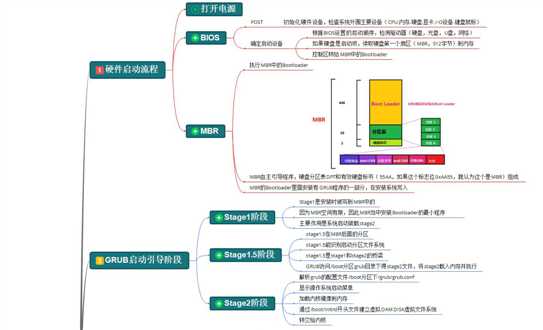

1.4 自制linux系统
1.4.1 分区并创建文件系统
#分两个必要的分区,/dev/sdb1对应/boot ?/dev/sdb2对应根 /
[root@centos6 ~]#echo -e ‘n
p
1
+1G
w
‘ | fdisk /dev/sdb
[root@centos6 ~]#echo -e ‘n
p
2
w
‘ | fdisk /dev/sdb
[root@centos6 ~]#mkfs.ext4 /dev/sdb1
[root@centos6 ~]#mkfs.ext4 /dev/sdb2
1.4.2 挂载boot
#子目录必须为boot
[root@centos6 ~]#mkdir /mnt/boot
[root@centos6 ~]#mount /dev/sdb1 /mnt/boot
1.4.3 安装grub
[root@centos6 ~]#grub-install --root-directory=/mnt/ /dev/sdb
1.4.4 准备内核和initramfs文件
[root@centos6 ~]#cp /boot/vmlinuz-2.6.32-754.el6.x86_64 /mnt/boot/vmlinuz
[root@centos6 ~]#cp /boot/initramfs-2.6.32-754.el6.x86_64.img
/mnt/boot/initramfs.img
1.4.5 建立grub.conf
[root@centos6 ~]#cat /mnt/boot/grub/grub.conf
default=0
timeout=6
title wang linux
root (hd0,0)
kernel /vmlinuz root=/dev/sda2 selinux=0 init=/bin/bash
initrd /initramfs.img
1.4.6 准备根下面相关程序和库
[root@centos6 ~]#mkdir /mnt/sysroot
[root@centos6 ~]#mount /dev/sdb2 ?/mnt/sysroot
[root@centos6 ~]#mkdir –pv
/mnt/sysroot/{boot,dev,sys,proc,etc,lib,lib64,bin,sbin,tmp,var,usr,opt,home,root
,mnt,media}
#复制bash等命令和相关库文件,如:
bash,ifconfig,insmod,ping,mount,ls,cat,df,lsblk,blkid,tree,fdisk
[root@centos6 ~]#mkdir /mnt/sysroot/{dev,proc,etc,sys,lib,home,root}
#准备网卡驱动
[root@centos6 ~]#ethtool -i eth0
driver: e1000
version: 7.3.21-k8-NAPI
firmware-version:
[root@centos6 ~]#modinfo -n e1000
/lib/modules/2.6.32-754.el6.x86_64/kernel/drivers/net/e1000/e1000.ko
[root@centos6 ~]#cp /lib/modules/2.6.32-
754.el6.x86_64/kernel/drivers/net/e1000/e1000.ko /mnt/sysroot/lib/
[root@centos6 ~]#chroot /mnt/sysroot
1.4.7 准备新的虚拟机
将前一虚拟机sdb硬盘对应的vmdk文件增加进去,删除原有磁盘,开机启动
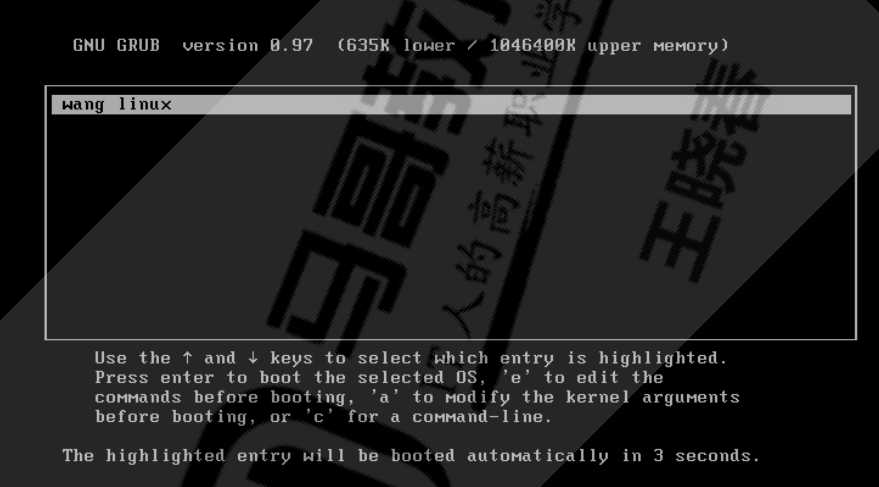
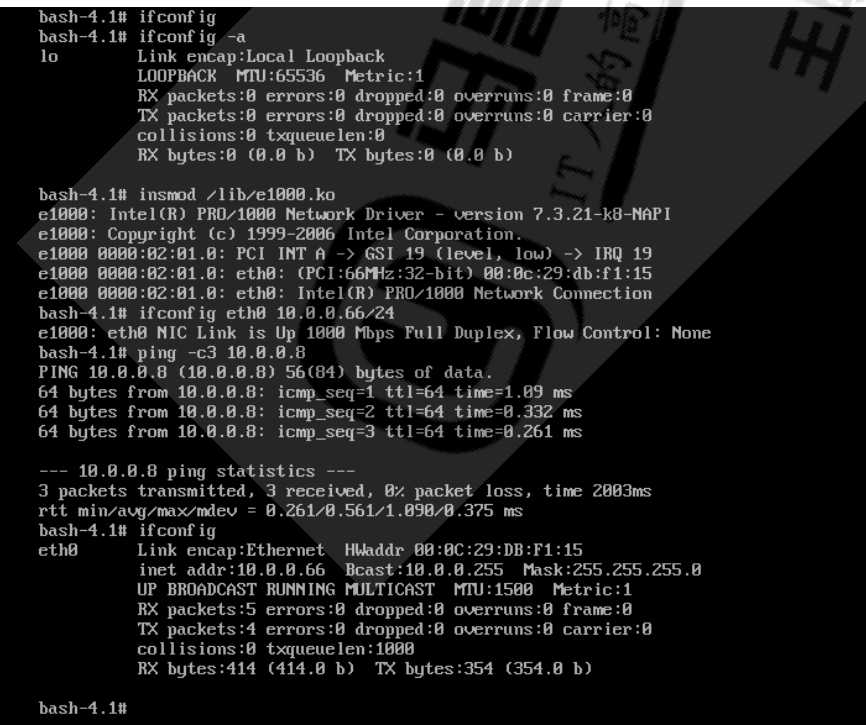
1.5 启动过程的故障排错
1.5.1 实战案例
故障: 删除 /sbin/init 无法启动
恢复过程
1 先进入grub菜单,在kernel参数后加 selinux=0 init=/bin/bash
2 mount -o remount,rw /
3 mount /dev/sr0 /mnt/
4 rpm2cpio /mnt/Packages/upstart.xxx.rpm | cpio -idv ./sbin/init
5 mv ./sbin/init /sbin/
1.5.2 实战案例
故障:rm -rf /boot/* 和 /etc/fstab 进行恢复
恢复过程
1. 用光盘进入 rescue mode,找到/ 所在分区并恢复/etc/fstab
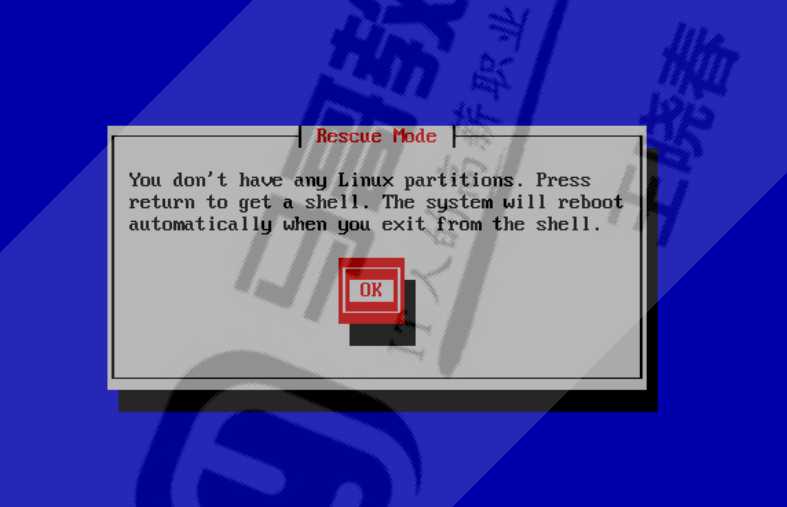
fdisk -l
mkdir /mnt/rootdir
mount /dev/sdaN /mnt/rootdir
ls /mnt/rootdir
mount /dev/sda2 /mnt/rootdir
vim /mnt/rootdir/etc/fstab
/dev/sda1 /boot ext4 defaults 0 0
/dev/sda2 / ?ext4 defaults 0 0
/dev/sda3 /data ext4 defaults 0 0
/dev/sda5 swap swap defaults 0 0
reboot
2. rescue mode 恢复内核和initrd 文件
/dev/sda2 --> /mnt/sysimage
chroot /mnt/sysimage
mount /dev/sr0 /mnt/
#方法1
rpm -ivh /mnt/Packages/kernel.xxxx.rpm --force
#方法2
cp /mnt/isolinux/vmlinuz /boot/
mkinitrd /boot/initramfs.img `uname -r`
3. 修复 grub
grub-install /dev/sda
vim /boot/grub/grub.conf 方法2
[root@centos6 ~]#cat /boot/grub/grub.conf
default=0
timeout=5
title centos
kernel /vmlinuz root=/dev/sda2
initrd /initramfs.img
4. reboot
2 /proc 目录和内核参数管理
/proc目录:内核把自己内部状态信息及统计信息,以及可配置参数通过proc伪文件系统加以输出
帮助:man proc
内核参数:
只读:只用于输出信息
可写:可接受用户指定“新值”来实现对内核某功能或特性的配置
/proc/sys 设置
sysctl命令用于查看或设定此目录中诸多参数
sysctl -w path.to.parameter=VALUE
默认配置文件:/etc/sysctl.conf 及以下文件
/run/sysctl.d/*.conf
/etc/sysctl.d/*.conf
/usr/local/lib/sysctl.d/*.conf
/usr/lib/sysctl.d/*.conf
/lib/sysctl.d/*.conf
/etc/sysctl.conf
范例:
sysctl -w kernel.hostname=mail.magedu.com
echo命令通过重定向方式也可以修改大多数参数的值
echo "VALUE" > /proc/sys/path/to/parameter
范例:
echo “websrv” > /proc/sys/kernel/hostname
sysctl命令:
(1) 临时设置某参数
sysctl -w parameter=VALUE
(2) 通过读取配置文件设置参数
sysctl -p [/path/to/conf_file]
(3) 查看所有生效参数
sysctl -a
常用的内核参数:
net.ipv4.ip_forward
net.ipv4.icmp_echo_ignore_all
net.ipv4.ip_nonlocal_bind ?#允许应用程序可以监听本地不存在的IP
vm.drop_caches
fs.file-max = 1020000
范例:
[root@centos8 ~]#cat /proc/sys/net/ipv4/icmp_echo_ignore_all
0
[root@centos8 ~]#vim /etc/sysctl.d/test.conf
[root@centos8 ~]#cat /etc/sysctl.d/test.conf
net.ipv4.icmp_echo_ignore_all=1
[root@centos8 ~]#sysctl -p /etc/sysctl.d/test.conf
net.ipv4.icmp_echo_ignore_all = 1
[root@centos8 ~]#cat /proc/sys/net/ipv4/icmp_echo_ignore_all
1
3 /sys 目录
/sys目录:
使用sysfs文件系统,为用户使用的伪文件系统,输出内核识别出的各硬件设备的相关属性信息,也有内
核对硬件特性的设定信息;有些参数是可以修改的,用于调整硬件工作特性
udev通过此路径下输出的信息动态为各设备创建所需要设备文件,udev是运行用户空间程序
专用工具:udevadmin, hotplug
udev为设备创建设备文件时,会读取其事先定义好的规则文件,一般在/etc/udev/rules.d
及/usr/lib/udev/rules.d目录下
4 内核模块管理和编译
单内核体系设计、但充分借鉴了微内核设计体系的优点,为内核引入模块化机制
内核组成部分:
kernel:内核核心,一般为bzImage,通常在/boot目录下
名称为 vmlinuz-VERSION-RELEASE
kernel object:内核对象,一般放置于
/lib/modules/VERSION-RELEASE/
initrd:从CentOS 5 版本以前
initramfs:从CentOS6 版本以后
4.1 内核版本
运行中的内核:
uname命令:
uname - print system information
uname [OPTION]...
-n: 显示节点名称
-r: 显示VERSION-RELEASE
-a:显示所有信息
4.2 内核模块命令
lsmod命令:
显示由核心已经装载的内核模块
显示的内容来自于: /proc/modules文件
范例:
[root@centos8 ~]#lsmod
Module ????????Size Used by
uas ??????????28672 ?0
usb_storage ??????73728 ?1 uas
nls_utf8 ???????16384 ?0
isofs ?????????45056 ?0
#显示:名称、大小,使用次数,被哪些模块依赖
modinfo命令:
功能:管理内核模块
配置文件:/etc/modprobe.conf, /etc/modprobe.d/*.conf
显示模块的详细描述信息
modinfo [ -k kernel ] [ modulename|filename... ]
常用选项:
-n:只显示模块文件路径
-p:显示模块参数
-a:作者
-d:描述
范例:
root@centos8 ~]#lsmod |grep xfs
xfs ????????1474560 2
libcrc32c ??????16384 1 xfs
[root@centos8 ~]#modinfo xfs
filename: ???/lib/modules/4.18.0-147.el8.x86_64/kernel/fs/xfs/xfs.ko.xz
license: ???GPL
description: ?SGI XFS with ACLs, security attributes, no debug enabled
author: ????Silicon Graphics, Inc.
alias: ????fs-xfs
rhelversion: ?8.1
srcversion: ??947E2EDC226CFCEC0F1F71B
depends: ???libcrc32c
intree: ????Y
name: ?????xfs
vermagic: ???4.18.0-147.el8.x86_64 SMP mod_unload modversions
sig_id: ????PKCS#7
signer: ????CentOS Linux kernel signing key
sig_key: ???79:05:D0:5C:21:6F:8A:C5:DD:6E:19:BB:77:9D:05:F6:F2:21:B8:17
sig_hashalgo: ?sha256
signature: ??C9:68:71:F6:2D:2A:F9:83:AC:A8:12:30:29:E3:61:1C:0C:2F:1E:7E:
装载或卸载内核模块
modprobe [ -C config-file ] [ modulename ] [ module parame-ters... ]
modprobe [ -r ] modulename…
范例:
[root@centos8 ~]#lsmod |grep usb
btusb ?????????53248 ?0
btrtl ?????????16384 ?1 btusb
btbcm ?????????16384 ?1 btusb
btintel ????????24576 ?1 btusb
bluetooth ??????630784 ?5 btrtl,btintel,btbcm,btusb
[root@centos8 ~]#modprobe usb_storage
[root@centos8 ~]#lsmod |grep usb
usb_storage ??????73728 ?0
btusb ?????????53248 ?0
btrtl ?????????16384 ?1 btusb
btbcm ?????????16384 ?1 btusb
btintel ????????24576 ?1 btusb
bluetooth ??????630784 ?5 btrtl,btintel,btbcm,btusb
[root@centos8 ~]#modprobe -r usb_storage
[root@centos8 ~]#lsmod |grep uas
#因为uas依赖usb_storage,安装uas会自动加载usb_storage
[root@centos8 ~]#modprobe uas
[root@centos8 ~]#lsmod |grep usb
usb_storage ??????73728 ?1 uas
btusb ?????????53248 ?0
btrtl ?????????16384 ?1 btusb
btbcm ?????????16384 ?1 btusb
btintel ????????24576 ?1 btusb
bluetooth ??????630784 ?5 btrtl,btintel,btbcm,btusb
[root@centos8 ~]#lsmod |grep -E ‘usb|uas‘
uas ??????????28672 ?0
usb_storage ??????73728 ?1 uas
btusb ?????????53248 ?0
btrtl ?????????16384 ?1 btusb
btbcm ?????????16384 ?1 btusb
btintel ????????24576 ?1 btusb
bluetooth ??????630784 ?5 btrtl,btintel,btbcm,btusb
#因为uas依赖usb_storage,无法直接卸载usb_storage
[root@centos8 ~]#modprobe -r usb_storage
modprobe: FATAL: Module usb_storage is in use.
#先卸载usb_storage,再卸载uas
[root@centos8 ~]#modprobe -r uas
[root@centos8 ~]#modprobe -r usb_storage
depmod命令:内核模块依赖关系文件及系统信息映射文件的生成工具
insmod命令:可以安装模块,需要指定模块文件路径,并且不自动解决依赖模块
insmod [ filename ] [ module options... ]
范例:
insmod `modinfo –n exportfs`
insmod `modinfo –n xfs`
rmmod命令:卸载模块
rmmod [ modulename ]
范例:
rmmod xfs
rmmod exportfs
4.3 编译内核
编译安装内核准备:
(1) 准备好开发环境
(2) 获取目标主机上硬件设备的相关信息
(3) 获取目标主机系统功能的相关信息,例如:需要启用相应的文件系统
(4) 获取内核源代码包, www.kernel.org
4.3.1 编译准备
4.3.1.1 目标主机硬件设备相关信息
CPU:
cat /proc/cpuinfo
x86info -a
lscpu
PCI设备:lspci -v ,-vv
[root@centos8 ~]#lspci
00:00.0 Host bridge: Intel Corporation 440BX/ZX/DX - 82443BX/ZX/DX Host bridge
(rev 01)
00:01.0 PCI bridge: Intel Corporation 440BX/ZX/DX - 82443BX/ZX/DX AGP bridge
(rev 01)
00:07.0 ISA bridge: Intel Corporation 82371AB/EB/MB PIIX4 ISA (rev 08)
00:07.1 IDE interface: Intel Corporation 82371AB/EB/MB PIIX4 IDE (rev 01)
00:07.3 Bridge: Intel Corporation 82371AB/EB/MB PIIX4 ACPI (rev 08)
00:07.7 System peripheral: VMware Virtual Machine Communication Interface (rev
10)
00:0f.0 VGA compatible controller: VMware SVGA II Adapter
00:10.0 SCSI storage controller: Broadcom / LSI 53c1030 PCI-X Fusion-MPT Dual
Ultra320 SCSI (rev 01)
00:11.0 PCI bridge: VMware PCI bridge (rev 02)
00:15.0 PCI bridge: VMware PCI Express Root Port (rev 01)
00:15.1 PCI bridge: VMware PCI Express Root Port (rev 01)
USB设备:lsusb -v,-vv
[root@centos8 ~]#dnf install usbutils -y
[root@centos8 ~]#lsusb
Bus 001 Device 004: ID 0951:1666 Kingston Technology DataTraveler 100 G3/G4/SE9
G2
Bus 001 Device 001: ID 1d6b:0002 Linux Foundation 2.0 root hub
Bus 002 Device 003: ID 0e0f:0002 VMware, Inc. Virtual USB Hub
Bus 002 Device 002: ID 0e0f:0003 VMware, Inc. Virtual Mouse
Bus 002 Device 001: ID 1d6b:0001 Linux Foundation 1.1 root hub
[root@centos8 ~]#lsmod |grep usb
usb_storage ?????73728 1 uas
lsblk 块设备
全部硬件设备信息:hal-device:CentOS 6
4.3.1.2 开发环境相关包
gcc make ncurses-devel flex bison openssl-devel elfutils-libelf-devel
4.3.1.3 内核编译安装实现
下载源码文件
准备文本配置文件/boot/config-`uname -r`
make menuconfig:配置内核选项 ,相当于./configure
[ ]: N
[M]: M
[*]: Y
make [-j #] 或者用以下两步实现:
make -j # bzImage
make -j # modules
安装模块:make modules_install
安装内核相关文件:make install
安装bzImage为 /boot/vmlinuz-VERSION-RELEASE
生成initramfs文件
编辑grub的配置文件
4.3.1.4 编译安装内核实战案例
[root@centos8 ~]#yum -y install gcc make ncurses-devel flex bison openssl-devel
elfutils-libelf-devel perl
[root@centos8 ~]#tar xf linux-5.6.12.tar.xz -C /usr/local/src
[root@centos8 ~]#cd /usr/local/src
[root@centos8 ~]#ln -sv linux-5.6.12 linux
[root@centos8 ~]#cd /usr/src/linux
[root@centos8 linux]#cp /boot/config-$(uname -r) ?./.config
[root@centos8 linux]#vim .config
#修改下面两行,CentOS7无需修改
# CONFIG_MODULE_SIG is not set
CONFIG_SYSTEM_TRUSTED_KEYS=""
[root@centos8 linux]#make help
[root@centos8 linux]#make menuconfig
[root@centos8 linux]#time make -j 2
#或者两步实现:make -j 2 bzImage ; make -j 2 modules
......
LD [M] sound/xen/snd_xen_front.ko
LD [M] virt/lib/irqbypass.ko
real 82m52.128s
user 133m37.982s
sys 25m46.311s
[root@centos8 linux]#pwd
/usr/local/src/linux
[root@centos8 linux]#du -sh .
15G .
[root@centos8 linux]#make modules_install
[root@centos8 linux]#ls /lib/modules
4.18.0-147.el8.x86_64 ?5.6.12-wanglinux-6.6.6
[root@centos8 linux]#du -sh /lib/modules/5.6.12-wanglinux-6.6.6/
3.5G /lib/modules/5.6.12-wanglinux-6.6.6/
[root@centos8 linux]#make install
[root@centos8 linux]#ls /boot
config-4.18.0-147.el8.x86_64
efi
grub2
initramfs-0-rescue-5b85fc7444b240a992c42ce2a9f65db5.img
initramfs-4.18.0-147.el8.x86_64.img
initramfs-4.18.0-147.el8.x86_64kdump.img
initramfs-5.6.12-wanglinux-6.6.6.img
loader
lost+found
System.map
System.map-4.18.0-147.el8.x86_64
System.map-5.6.12-wanglinux-6.6.6
vmlinuz
vmlinuz-0-rescue-5b85fc7444b240a992c42ce2a9f65db5
vmlinuz-4.18.0-147.el8.x86_64
vmlinuz-5.6.12-wanglinux-6.6.6
[root@centos8 ~]#ls /boot/loader/entries/
5b85fc7444b240a992c42ce2a9f65db5-0-rescue.conf
5b85fc7444b240a992c42ce2a9f65db5-4.18.0-147.el8.x86_64.conf
5b85fc7444b240a992c42ce2a9f65db5-5.6.12-wanglinux-6.6.6.conf
[root@centos8 ~]#cat /boot/loader/entries/5b85fc7444b240a992c42ce2a9f65db5-
5.6.12-wanglinux-6.6.6.conf
title CentOS Linux (5.6.12-wanglinux-6.6.6) 8 (Core)
version 5.6.12-wanglinux-6.6.6
linux /vmlinuz-5.6.12-wanglinux-6.6.6
initrd /initramfs-5.6.12-wanglinux-6.6.6.img $tuned_initrd
options $kernelopts $tuned_params
id centos-20200513060531-5.6.12-wanglinux-6.6.6
grub_users $grub_users
grub_arg --unrestricted
grub_class kernel
[root@centos8 ~]#reboot
[root@centos8 ~]#uname -r
5.6.12-wanglinux-6.6.6
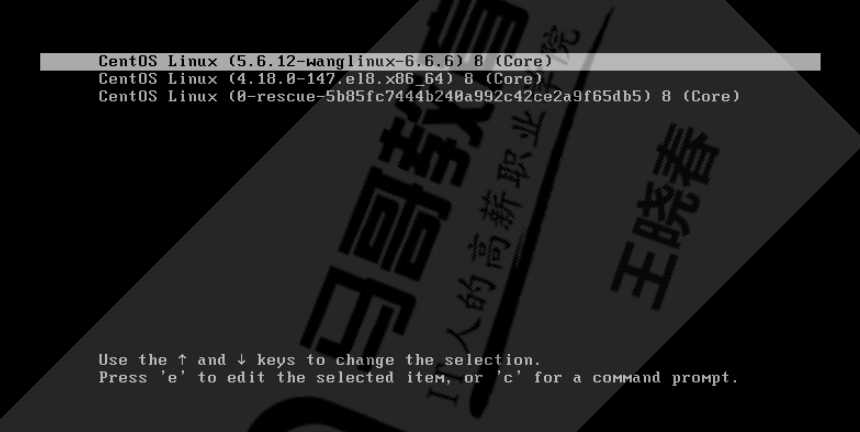
4.3.1.4 内核编译说明
1. 配置内核选项
支持“更新”模式进行配置:make help
(a) make config:基于命令行以遍历的方式配置内核中可配置的每个选项
(b) make menuconfig:基于curses的文本窗口界面
(c) make gconfig:基于GTK (GNOME)环境窗口界面
(d) make xconfig:基于QT(KDE)环境的窗口界面
支持“全新配置”模式进行配置
(a) make defconfig:基于内核为目标平台提供的“默认”配置进行配置
(b) make allyesconfig: 所有选项均回答为“yes“
(c) make allnoconfig: 所有选项均回答为“no“
2. 编译内核
全编译:
make [-j #]
编译内核的一部分功能:
(a) 只编译某子目录中的相关代码
cd /usr/src/linux; make dir/
(b) 只编译一个特定的模块
cd /usr/src/linux; make dir/file.ko
范例:只为e1000编译驱动:
make drivers/net/ethernet/intel/e1000/e1000.ko
3 交叉编译内核
编译的目标平台与当前平台不相同
make ARCH=arch_name
要获取特定目标平台的使用帮助
make ARCH=arch_name help
示例:
make ARCH=arm help
4 重新编译需要事先清理操作
make clean:清理大多数编译生成的文件,但会保留.config文件等
make mrproper: 清理所有编译生成的文件、config及某些备份文件
make distclean:包含 make mrproper,并清理patches以及编辑器备份文件
4.3.1.5 卸载内核
删除/usr/src/linux/目录下不需要的内核源码
删除/lib/modules/目录下不需要的内核库文件
删除/boot目录下启动的内核和内核映像文件
更改grub的配置文件,删除不需要的内核启动列表 grub2-mkconfig -o /boot/grub2/grub.cfg
CentOS 8 还需要删除 /boot/loader/entries/5b85fc7444b240a992c42ce2a9f65db5-新内核版
本.conf
5 Busybox

5.1 Busybox介绍
Busybox 最初是由 Bruce Perens 在 1996 年为 Debian GNU/Linux 安装盘编写的。其目标是在一张软
盘(存储空间只有1MB多)上创建一个GNU/Linux 系统,可以用作安装盘和急救盘
Busybox 是一个开源项目,遵循GPL v2协议。Busybox将众多的UNIX命令集合进一个很小的可执行程
序中,可以用来替代GNU fileutils、shellutils 等工具集。Busybox中各种命令与相应的GNU工具相
比,所能提供的选项比较少,但是也足够一般的应用了。Busybox主要用于嵌入式系统
Busybox 是一个集成了三百多个最常用Linux命令和工具的软件。BusyBox 包含了一些简单的工具,例
如ls、cat和echo等等,还包含了一些更大、更复杂的工具,例grep、find、mount以及telnet。有些人
将 BusyBox 称为 Linux 工具里的瑞士军刀。简单的说BusyBox就好像是个大工具箱,它集成压缩了
Linux 的许多工具和命令,也包含了 android 系统的自带的shell
定制小型的Linux操作系统:linux内核+busybox
官方网站:https://busybox.net/
5.2 Busybox使用
busybox 的编译过程与Linux内核的编译类似
busybox的使用有三种方式:
busybox后直接跟命令,如 busybox ls
直接将busybox重命名,如 cp busybox tar
创建符号链接,如 ln -s busybox rm
busybox的安装
以上方法中,第三种方法最方便,但为busybox中每个命令都创建一个软链接,相当费事,busybox提
供自动方法:busybox编译成功后,执行make install,则会产生一个_install目录,其中包含了busybox
及每个命令的软链接
编译Busybox
5.3 busybox编译安装
[root@centos7 ~]#yum -y install ?gcc gcc-c++ glibc glibc-devel make pcre pcre-
devel openssl openssl-devel systemd-devel zlib-devel glibc-static ncurses-devel
[root@centos7 ~]#wget https://busybox.net/downloads/busybox-1.31.1.tar.bz2
[root@centos7 ~]#tar xvf busybox-1.31.1.tar.bz2
[root@centos7 ~]#cd busybox-1.31.1/
[root@centos7 busybox-1.31.1]#make menuconfig #按下面选择,把busybox编译也静态二进
制、不用共享库:Settings -->Build Options -->[*] Build static binary (no shared
libs)
[root@centos7 busybox-1.31.1]#make #如果出错,执行make clean后,重新执行上面命令
[root@centos7 busybox-1.31.1]#ls
[root@centos7 busybox-1.31.1]#make install
[root@centos7 busybox-1.31.1]#pwd
/root/busybox-1.31.1
[root@centos7 busybox-1.31.1]#ls
applets ????????debianutils loginutils ?????
qemu_multiarch_testing
applets_sh ??????docs ????mailutils ???????README
arch ?????????e2fsprogs ?Makefile ???????runit
archival ???????editors ??Makefile.custom ????scripts
AUTHORS ????????examples ??Makefile.flags ????selinux
busybox ????????findutils ?Makefile.help ?????shell
busybox.links ?????include ??make_single_applets.sh
size_single_applets.sh
busybox_unstripped ??init ????miscutils ???????sysklogd
busybox_unstripped.map _install ??modutils ???????testsuite
busybox_unstripped.out INSTALL ??networking ??????TODO
Config.in ???????klibc-utils NOFORK_NOEXEC.lst ???TODO_unicode
configs ????????libbb ???NOFORK_NOEXEC.sh ???util-linux
console-tools ?????libpwdgrp ?printutils
coreutils ???????LICENSE ??procps
[root@centos7 busybox-1.31.1]#ll busybox -h
-rwxr-xr-x 1 root root 2.6M May 13 14:46 busybox
[root@centos7 busybox-1.31.1]#ls _install/
bin linuxrc sbin usr
[root@centos7 busybox-1.31.1]#ls _install/bin
arch ??dd ??????grep ??login ???netstat ???rmdir ????tar
ash ???df ??????gunzip ?ls ????nice ?????rpm ????
touch
base64 ?dmesg ????gzip ??lsattr ??nuke ?????run-parts ??true
busybox ?dnsdomainname hostname lzop ???pidof ????scriptreplay
umount
cat ???dumpkmap ???hush ??makemime ?ping ?????sed ????
uname
chattr ?echo ?????ionice ?mkdir ???ping6 ????setarch ??
usleep
chgrp ??ed ??????iostat ?mknod ???pipe_progress setpriv ???vi
chmod ??egrep ????ipcalc ?mktemp ??printenv ???setserial ?
watch
chown ??false ????kbd_mode more ???ps ??????sh ?????zcat
conspy ?fatattr ???kill ??mount ???pwd ?????sleep
cp ???fdflush ???link ??mountpoint reformime ??stat
cpio ??fgrep ????linux32 ?mpstat ??resume ????stty
cttyhack fsync ????linux64 ?mt ????rev ?????su
date ??getopt ????ln ???mv ????rm ??????sync
[root@centos7 busybox-1.31.1]#find _install/ -type l |wc -l
396
[root@centos7 busybox-1.31.1]#du -sh _install/
2.6M _install/
[root@centos7 busybox-1.31.1]#mkdir /mnt/sysroot/
[root@centos7 busybox-1.31.1]#cp -a _install/* /mnt/sysroot/
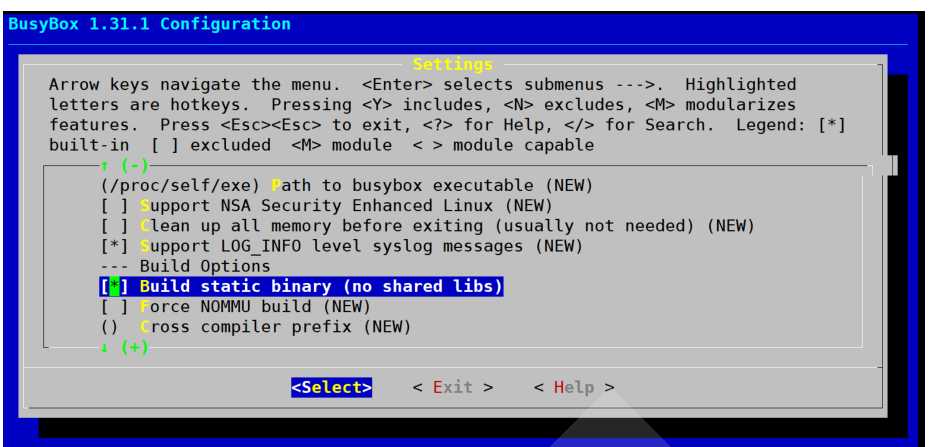
6 systemd
6.1 systemd 特性
Systemd:从 CentOS 7 版本之后开始用 systemd 实现init进程,系统启动和服务器守护进程管理器,
负责在系统启动或运行时,激活系统资源,服务器进程和其它进程
Systemd新特性
系统引导时实现服务并行启动
按需启动守护进程
自动化的服务依赖关系管理
同时采用socket式与D-Bus总线式激活服务
socket与服务程序分离
向后兼容sysv init脚本
使用systemctl 命令管理,systemctl命令固定不变,不可扩展,非由systemd启动的服务,
systemctl无法与之通信和控制
系统状态快照
systemd核心概念:unit
unit表示不同类型的systemd对象,通过配置文件进行标识和配置;文件中主要包含了系统服务、监听
socket、保存的系统快照以及其它与init相关的信息
Unit类型:
#查看unit类型
[root@centos8 ~]#systemctl -t help
Available unit types:
service
socket
target
device
mount
automount
swap
timer
path
slice
scope
service unit: 文件扩展名为.service, 用于定义系统服务
Socket unit: .socket, 定义进程间通信用的socket文件,也可在系统启动时,延迟启动服务,实现
按需启动
Target unit: 文件扩展名为.target,用于模拟实现运行级别
Device unit: .device, 用于定义内核识别的设备
Mount unit: .mount, 定义文件系统挂载点
Snapshot unit: .snapshot, 管理系统快照
Swap unit: .swap, 用于标识swap设备
Automount unit: .automount,文件系统的自动挂载点
Path unit: .path,用于定义文件系统中的一个文件或目录使用,常用于当文件系统变化时,延迟激
活服务,如:spool 目录
unit的配置文件
/usr/lib/systemd/system:每个服务最主要的启动脚本设置,类似于之前的/etc/init.d/
/lib/systemd/system: ubutun的对应目录
/run/systemd/system:系统执行过程中所产生的服务脚本,比上面目录优先运行
/etc/systemd/system:管理员建立的执行脚本,类似于/etc/rcN.d/Sxx的功能,比上面目录优先运行
6.2 systemctl管理系统服务service unit
命令:
systemctl COMMAND name.service
#启动:相当于service name start
systemctl start name.service
#停止:相当于service name stop
systemctl stop name.service
#重启:相当于service name restart
systemctl restart name.service
#查看状态:相当于service name status
systemctl status name.service
#禁止自动和手动启动:
systemctl mask name.service
#取消禁止
systemctl unmask name.service
#查看某服务当前激活与否的状态:
systemctl is-active name.service
#查看所有已经激活的服务:
systemctl list-units --type|-t service
#查看所有服务:
systemctl list-units --type service --all|-a
#设定某服务开机自启,相当于chkconfig name on
systemctl enable name.service
#设定某服务开机禁止启动:相当于chkconfig name off
systemctl disable name.service
#查看所有服务的开机自启状态,相当于chkconfig --list
systemctl list-unit-files --type service
#用来列出该服务在哪些运行级别下启用和禁用:chkconfig –list name
ls /etc/systemd/system/*.wants/name.service
#查看服务是否开机自启:
systemctl is-enabled name.service
#列出失败的服务
systemctl --failed --type=service
#开机并立即启动或停止
systemctl enable --now postfix
systemctl disable ?--now postfix
#查看服务的依赖关系:
systemctl list-dependencies name.service
#杀掉进程:
systemctl kill unitname
服务状态
#显示状态
systemctl list-unit-files --type service --all
loaded Unit配置文件已处理
active(running) 一次或多次持续处理的运行
active(exited) 成功完成一次性的配置
active(waiting) 运行中,等待一个事件
inactive 不运行
enabled 开机启动
disabled 开机不启动
static 开机不启动,但可被另一个启用的服务激活
indirect 重定向到别处
范例:systemctl 命令示例
#显示所有单元状态
systemctl 或 systemctl list-units
#只显示服务单元的状态
systemctl --type=service
#显示sshd服务单元
systemctl –l status sshd.service
#验证sshd服务当前是否活动
systemctl is-active sshd
#启动,停止和重启sshd服务
systemctl start sshd.service
systemctl stop sshd.service
systemctl restart sshd.service
#重新加载配置
systemctl reload sshd.service
#列出活动状态的所有服务单元
systemctl list-units --type=service
#列出所有服务单元
systemctl list-units --type=service --all
#查看服务单元的启用和禁用状态
systemctl list-unit-files --type=service
#列出依赖的单元
systemctl list-dependencies sshd
验证sshd服务是否开机启动
systemctl is-enabled sshd
禁用network,使之不能自动启动,但手动可以
systemctl disable network
#启用network
systemctl enable network
#禁用network,使之不能手动或自动启动
systemctl mask network
#启用network
systemctl unmask network
6.3 service unit文件格式
/etc/systemd/system:系统管理员和用户使用
/usr/lib/systemd/system:发行版打包者使用
帮助参考:
systemd.directives(7),systemd.unit(5),systemd.service(5), systemd.socket(5),
systemd.target(5),systemd.exec(5)
unit 格式说明:
以 “#” 开头的行后面的内容会被认为是注释
相关布尔值,1、yes、on、true 都是开启,0、no、off、false 都是关闭
时间单位默认是秒,所以要用毫秒(ms)分钟(m)等须显式说明
service unit file文件通常由三部分组成:
[Unit]:定义与Unit类型无关的通用选项;用于提供unit的描述信息、unit行为及依赖关系等
[Service]:与特定类型相关的专用选项;此处为Service类型
[Install]:定义由“systemctl enable”以及"systemctl disable“命令在实现服务启用或禁用时用到
的一些选项
Unit段的常用选项:
Description:描述信息
After:定义unit的启动次序,表示当前unit应该晚于哪些unit启动,其功能与Before相反
Requires:依赖到的其它units,强依赖,被依赖的units无法激活时,当前unit也无法激活
Wants:依赖到的其它units,弱依赖
Conflicts:定义units间的冲突关系
[root@centos8 ~]#head -n 5 /lib/systemd/system/postfix.service
[Unit]
Description=Postfix Mail Transport Agent
After=syslog.target network.target
Conflicts=sendmail.service exim.service
Service段的常用选项:
Type:定义影响ExecStart及相关参数的功能的unit进程启动类型
simple:默认值,这个daemon主要由ExecStart接的指令串来启动,启动后常驻于内存中
forking:由ExecStart启动的程序透过spawns延伸出其他子程序来作为此daemon的主要服
务。原生父程序在启动结束后就会终止
oneshot:与simple类似,不过这个程序在工作完毕后就结束了,不会常驻在内存中
dbus:与simple类似,但这个daemon必须要在取得一个D-Bus的名称后,才会继续运作.因
此通常也要同时设定BusNname= 才行
notify:在启动完成后会发送一个通知消息。还需要配合 NotifyAccess 来让 Systemd 接收消
息
idle:与simple类似,要执行这个daemon必须要所有的工作都顺利执行完毕后才会执行。这
类的daemon通常是开机到最后才执行即可的服务
EnvironmentFile:环境配置文件
ExecStart:指明启动unit要运行命令或脚本的绝对路径
ExecStartPre: ExecStart前运行
ExecStartPost: ExecStart后运行
ExecStop:指明停止unit要运行的命令或脚本
Restart:当设定Restart=1 时,则当次daemon服务意外终止后,会再次自动启动此服务
PrivateTmp:设定为yes时,会在生成/tmp/systemd-private-UUID-NAME.service-XXXXX/tmp/
目录
Install段的常用选项:
Alias:别名,可使用systemctl command Alias.service
RequiredBy:被哪些units所依赖,强依赖
WantedBy:被哪些units所依赖,弱依赖
Also:安装本服务的时候还要安装别的相关服务
注意:对于新创建的unit文件,或者修改了的unit文件,要通知systemd重载此配置文件,而后可以选择
重启
systemctl daemon-reload
范例:服务Unit文件
[Unit]
Description=The nginx HTTP Server daemon # 描述信息
After=network.target remote-fs.target nss-lookup.target # 指定启动nginx之前需要其他
的其他服务,如network.target等
[Service]
# Type为服务类型,仅启动一个主进程的服务为simple,需要启动若干子进程的服务为forking
Type=forking
# 设置执行systemctl start nginx后需要启动的具体命令
ExecStart=/usr/local/nginx/sbin/nginx
# 设置执行systemctl reload nginx后需要执行的具体命令
ExecReload=/usr/local/nginx/sbin/nginx -s reload
# 设置执行systemctl stop nginx后需要执行的具体命令
ExecStop=/bin/kill -s QUIT ${MAINPID}
[Install]
# 设置在什么模式下被安装,设置开机启动的时候需要
WantedBy=multi-user.target
范例:服务Unit文件示例
vim /usr/lib/systemd/system/tomcat.service
[Unit]
Description=java tomcat project
After=syslog.target network.target
[Service]
Type=forking
EnvironmentFile=/usr/local/tomcat/conf/tomcat.conf
ExecStart=/usr/local/tomcat/bin/startup.sh
ExecStop=/usr/local/tomcat/bin/shutdown.sh
PrivateTmp=true
User=tomcat
[Install]
WantedBy=multi-user.target
范例:服务Unit文件示例
vim /etc/systemd/system/bak.service
[Unit]
Description=backup /etc
Requires=atd.service
[Service]
Type=simple
ExecStart=/bin/bash -c "echo /data/bak.sh | at now"
[Install]
WantedBy=multi-user.target
systemctl daemon-reload
systemctl start bak
范例:Ubutun实现开机自动运行程序
root@ubuntu1804 ~]#ll /lib/systemd/system/rc.local.service
lrwxrwxrwx 1 root root 16 Dec 12 ?2018 /lib/systemd/system/rc.local.service ->
rc-local.service
[root@ubuntu1804 ~]#grep -v "^#" /lib/systemd/system/rc.local.service
[Unit]
Description=/etc/rc.local Compatibility
Documentation=man:systemd-rc-local-generator(8)
ConditionFileIsExecutable=/etc/rc.local
After=network.target
[Service]
Type=forking
ExecStart=/etc/rc.local start
TimeoutSec=0
RemainAfterExit=yes
GuessMainPID=no
[root@ubuntu1804 ~]#vim /etc/rc.local
[root@ubuntu1804 ~]#cat /etc/rc.local
#!/bin/bash
echo -e ‘E[31;1mstarting test serviceE[0m‘
sleep 10
[root@ubuntu1804 ~]#chmod +x /etc/rc.local
[root@ubuntu1804 ~]#reboot
6.4 运行级别
target units:相当于CentOS 6之前的runlevel ,unit配置文件:.target
ls /usr/lib/systemd/system/*.target
systemctl list-unit-files --type target --all
和运行级别对应关系
0 ==> runlevel0.target, poweroff.target
1 ==> runlevel1.target, rescue.target
2 ==> runlevel2.target, multi-user.target
3 ==> runlevel3.target, multi-user.target
4 ==> runlevel4.target, multi-user.target
5 ==> runlevel5.target, graphical.target
6 ==> runlevel6.target, reboot.target
查看依赖性:
systemctl list-dependencies graphical.target
级别切换:相当于 init N
systemctl isolate name.target
进入默认target
systemctl default
范例:
#切换至字符模式
systemctl isolate multi-user.target
注意:只有/lib/systemd/system/*.target文件中AllowIsolate=yes 才能切换(修改文件需执行systemctl
daemon-reload才能生效)
获取默认运行级别: 相当于查看 /etc/inittab
systemctl get-default
修改默认级别:相当于修改 /etc/inittab
systemctl set-default name.target
范例:
[root@centos8 ~]#systemctl set-default multi-user.target
[root@centos8 ~]#ls -l /etc/systemd/system/default.target
lrwxrwxrwx. 1 root root 37 Nov 7 19:32 /etc/systemd/system/default.target ->
/lib/systemd/system/multi-user.target
切换至紧急救援模式:
systemctl rescue
切换至emergency模式:
systemctl emergency
说明:rescue.target 比emergency 支持更多的功能,例如日志等
传统命令init,poweroff,halt,reboot都成为 systemctl的软链接
#关机
systemctl halt、systemctl poweroff
#重启:
systemctl reboot
#挂起:
systemctl suspend
#休眠:
systemctl hibernate
#休眠并挂起:
systemctl hybrid-sleep
范例:禁用ctrl+alt+delete 重启快捷键
root@centos8 ~]#ls -l /lib/systemd/system/ctrl-alt-del.target ?
lrwxrwxrwx. 1 root root 13 May 23 2019 /lib/systemd/system/ctrl-alt-del.target
-> reboot.target
[root@centos8 ~]#systemctl mask ctrl-alt-del.target
Created symlink /etc/systemd/system/ctrl-alt-del.target → /dev/null.
[root@centos8 ~]#init q
[root@centos8 ~]#systemctl daemon-reload
6.5 CentOS 7之后版本引导顺序
1. UEFi或BIOS初始化,运行POST开机自检
2. 选择启动设备
3. 引导装载程序, centos7是grub2,加载装载程序的配置文件:
/etc/grub.d/
/etc/default/grub
/boot/grub2/grub.cfg
4. 加载initramfs驱动模块
5. 加载内核选项
6. 内核初始化,centos7使用systemd代替init
7. 执行initrd.target所有单元,包括挂载/etc/fstab
8. 从initramfs根文件系统切换到磁盘根目录
9. systemd执行默认target配置,配置文件/etc/systemd/system/default.target
10. systemd执行sysinit.target初始化系统及basic.target准备操作系统
11. systemd启动multi-user.target下的本机与服务器服务
12. systemd执行multi-user.target下的/etc/rc.d/rc.local
13. Systemd执行multi-user.target下的getty.target及登录服务
14. systemd执行graphical需要的服务
通过systemd-analyze 工具可以了解启动的详细过程
范例:
[root@centos8 ~]#systemd-analyze blame
????1.862s kdump.service
????1.047s tuned.service
?????666ms dracut-initqueue.service
?????523ms auditd.service
?????379ms initrd-switch-root.service
?????314ms sssd.service
?????302ms systemd-rfkill.service
?????219ms NetworkManager-wait-online.service
?????211ms polkit.service
?????178ms systemd-udev-trigger.service
?????159ms dracut-pre-pivot.service
?????138ms autofs.service
?????129ms systemd-vconsole-setup.servi
范例:生成网页
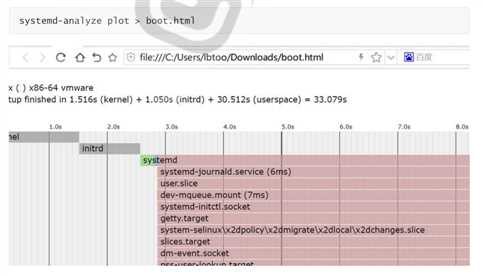
6.6 设置内核参数
设置内核参数,只影响当次启动
启动时,到启动菜单,按e键,找到在linux 开头的行后添加systemd.unit=desired.target
比如:systemd.unit=emergency.target 或 systemd.unit=rescue.target
6.7 破解 CentOS 7和8的 root 密码
启动时任意键暂停启动
按e键进入编辑模式
将光标移动linux 开始的行,添加内核参数rd.break
按ctrl-x启动
mount –o remount,rw /sysroot
chroot /sysroot
passwd root
#如果SELinux是启用的,才需要执行下面操作,如查没有启动,不需要执行
touch /.autorelabel
exit
reboot
启动时任意键暂停启动
按e键进入编辑模式
将光标移动linux 开始的行,改为rw init=/sysroot/bin/sh
按ctrl-x启动
chroot /sysroot
passwd root
#如果SELinux是启用的,才需要执行下面操作,如查没有启动,不需要执行
touch /.autorelabel
exit
reboot
6.8 实现GRUB2安全
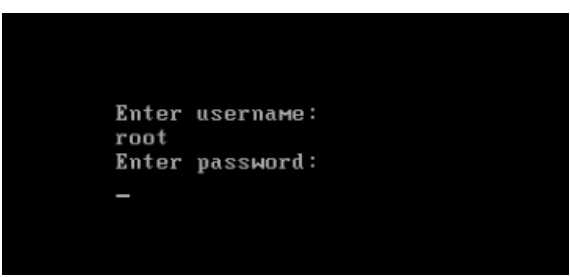
#添加grub密码
[root@centos8 ~]#grub2-setpassword
Enter password:
Confirm password:
[root@centos8 ~]#ls -l /boot/grub2/
total 32
drwxr-xr-x 2 root root ?4096 Jan 19 15:17 fonts
-rw-r--r-- 1 root root ?5101 Jan 19 15:18 grub.cfg
-rw-r--r-- 1 root root ?1024 Jan 19 15:18 grubenv
drwxr-xr-x 2 root root 12288 Jan 19 15:17 i386-pc
-rw------- 1 root root ?298 Jan 19 18:20 user.cfg
[root@centos8 ~]#ls -l /boot/grub2/user.cfg
-rw------- 1 root root 298 Jan 19 18:20 /boot/grub2/user.cfg
[root@centos8 ~]#cat /boot/grub2/user.cfg
GRUB2_PASSWORD=grub.pbkdf2.sha512.10000.60AAA29A65F4DC77E8861EF25BDE2034C9B30CE1
E07EE688D7F30460E7E87E7356B0893A6DFFB250B27D2EB9D3ED3E9207199C494D7882E2E8C772C8
2E2DDB7A.5E42FD69FA04293DECD68F077E83875A8E4572A7FBB89BA9F161B15EAFE54FBA963FE5D
52E16764944823396231803E5118DA1D9CAF3EB73C175A7D7A3682A90
#清空grub密码
[root@centos8 ~]#cat /dev/null > /boot/grub2/user.cfg
6.9 修复GRUB2
GRUB2:CentOS 7,8及ubuntu1804都使用
引导提示时可以使用命令行界面,可从文件系统引导
主要配置文件:/boot/grub2/grub.cfg
修复配置文件:grub2-mkconfig > /boot/grub2/grub.cfg
修复grub
grub2-install /dev/sda #BIOS环境
grub2-install #UEFI环境
范例:调整默认启动内核
[root@centos8 ~]#cat /boot/grub2/grubenv
# GRUB Environment Block
saved_entry=5b85fc7444b240a992c42ce2a9f65db5-5.6.12-wanglinux-6.6.6
kernelopts=root=UUID=f7f53add-b184-4ddc-8d2c-5263b84d1e15 ro crashkernel=auto
resume=UUID=eebe3bc7-6d52-4ad9-86aa-916f1a123fd4 rhgb quiet net.ifnames=0
boot_success=0
################################################################################
################################################################################
################################################################################
################################################################################
################################################################################
################################################################################
################################################################################
################################################################################
################################################################################
###########################################[root@centos8 ~]#cd
[root@centos8 ~]#ls /boot/loader/entries/
5b85fc7444b240a992c42ce2a9f65db5-0-rescue.conf
5b85fc7444b240a992c42ce2a9f65db5-4.18.0-147.el8.x86_64.conf
5b85fc7444b240a992c42ce2a9f65db5-5.6.12-wanglinux-6.6.6.conf
#以下命令是修改 /boot/grub2/grubenv 实现
[root@centos8 ~]#grub2-set-default 1
#或者
[root@centos8 ~]#vim /etc/default/grub
GRUB_DEFAULT=1
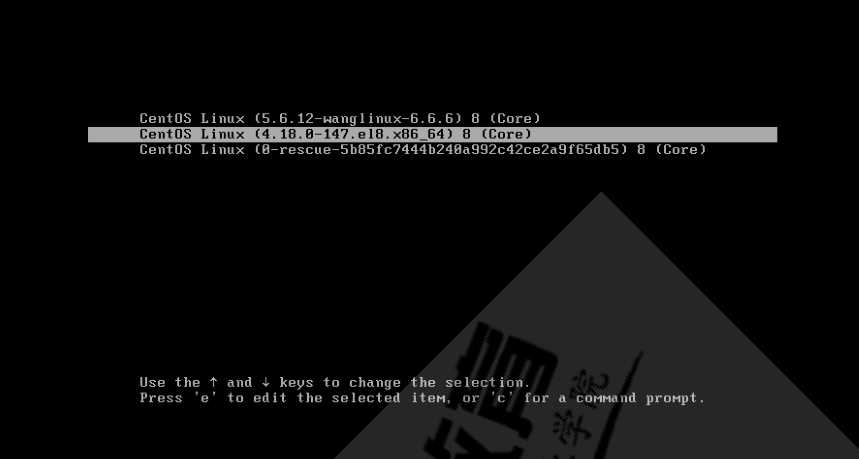
6.10 故障排错实战案例
6.10.1 实战案例1:centos 7 ,8 破坏MBR后进行恢复
dd if=/dev/zero of=/dev/sda bs=1 count=446
光盘进入救援模式
grub2-install --root-directory=/mnt/sysimage /dev/sda
6.10.2 实战案例2:entos 7 ,8删除/boot/grub2/*所有内容进行恢复

光盘进入救援模式
chroot /mnt/sysimage
grub2-install /dev/sda
grub2-mkconfig -o /boot/grub2/grub.cfg
6.10.3 实战案例3:CentOS 7 ,8 删除/boot/下所有文件后进行恢复
1 光盘救援模式下安装grub2
特别说明:Centos8 必须先grub,再安装kernel,否则安装kernel-core时会提示grub出错
chroot /mnt/sysimage
mount /dev/sr0 /mnt
grub2-install /dev/sda
2安装Kernel
#CentOS 7
rpm –ivh /mnt/Packages/kernel-3.10.0-1062.el7.x86_64.rpm --force
#CentOS 8
rpm -ivh /mnt/BaseOS/Packages/kernel-core-4.18.0-147.el8.x86_64.rpm --force
3修复grub配置文件
生成grub2.cfg文件
grub2-mkconfig –o /boot/grub2/grub.cfg
4 退出重启
exit
exit以上是关于系统启动和内核管理的主要内容,如果未能解决你的问题,请参考以下文章